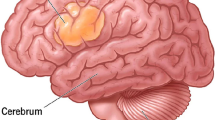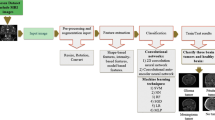Abstract
Brain tumors present the most unique challenge to clinicians in terms of their detection and assessment. The identification of brain lesions and tumors are often performed by magnetic resonance imaging (MRI) diagnostics. This study proposes a machine learning technique to detect and localize brain tumors via MRI of the brain with a two-phased approach. Phase one encompassed the preprocessing of the MRI images to improve the image contrast and then apply the Fractional Hartley Transform method to the preprocessed MRI. The coefficients of this transformation were used to construct the feature vectors that were used to classify a given MRI of the brain as normal or abnormal based on the adaptive neuro-fuzzy inference system (ANFIS) approach. Phase two corresponded with the localization of the regions with tumors in the abnormal brain images with the aid of morphological operations. The entire process was evaluated using multiple performance metrics, i.e., sensitivity, specificity, accuracy, and classification rate. Without considering the clinical dataset, the study results achieved corresponded to 99.4% of sensitivity, 99.2% of specificity, and 99.3% of accuracy; however, when considering the brain tumor image segmentation (BRATS) 2015 clinical dataset, the results achieved corresponded to 97.24% of sensitivity, 97.98% of specificity, and 97.54% of accuracy in the tumor detection process. These approaches are of extreme importance in the automated estimation of tumors via MR brain images and aid the clinicians to determine a precise clinical diagnosis, using robust machine learning techniques to mitigate human errors.





Similar content being viewed by others
References
Anitha R, Raja DS (2017) Segmentation of glioma tumors using convolutional neural networks. Int J Imaging Syst Technol 27:354–360
BRATS database (2015). https://www.smir.ch/BRATS/Start2015
Choudhury CL, Mahanty C, Kumar R, Mishra BK (2020) Brain tumor detection and classification using convolutional neural network and deep neural network. In: 2020 international conference on computer science, engineering and applications (ICCSEA). IEEE
Irsheidat S, Duwairi R (2020) Brain tumor detection using artificial convolutional neural networks. In: 2020 11th international conference on information and communication systems (ICICS). IEEE
Kathirvel R, Batri K (2017) A computer-aided approach for meningioma brain tumor detection using C ANFIS classifier. Int J Imaging Syst Technol 27:193–200
Lather M, Singh P (2020) Investigating brain tumor segmentation and detection techniques. Proc Comput Sci 167:121–130
Pereira S, Pinto A, Alves V, Silva CA (2016) Brain tumor segmentation using convolutional neural networks in MRI images. IEEE Trans Med Imaging 35:1240–1251
Rao CH, Naganjaneyulu PV, Prasad KS (2017) Brain tumor detection and segmentation using conditional random field. In: 2017 IEEE 7th international advance computing conference (IACC). IEEE
Reboucas Filho PP, da Silva Barros AC, Almeida JS, Rodrigues JP, de Albuquerque VH (2019) A new effective and powerful medical image segmentation algorithm based on optimum path snakes. Appl Soft Comput 76:649–670
Sunil LB, Pradeepini G, Shrishailappa TP (2018) Implementation for brain tumor detection and threedimensional visualization model development for reconstruction. ARPN J Eng Appl Sci 13(2):467–473
Author information
Authors and Affiliations
Corresponding author
Additional information
Publisher's Note
Springer Nature remains neutral with regard to jurisdictional claims in published maps and institutional affiliations.
Rights and permissions
About this article
Cite this article
Nagabushanam, M., Nandeesh, G.S., Venkateshappa et al. Detection and localization of brain tumors using Fractional Hartley Transform and adaptive neuro-fuzzy inference system classification methods. J Ambient Intell Human Comput 14, 8851–8858 (2023). https://doi.org/10.1007/s12652-021-03633-8
Received:
Accepted:
Published:
Issue Date:
DOI: https://doi.org/10.1007/s12652-021-03633-8




